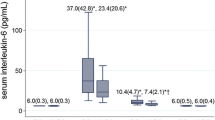Summary
Production of inflammatory mediators (IM) by cells and specifically macrophages around loosened implants may be responsible for their loosening. Our hypothesis was that different materials give rise to different amounts of these IM. It is thought that alumina/alumina for total hip replacement (THR), which has been used for 15 years in our orthopedic department, may produce less IM than other systems. We initiated a clinical prospective study to measure the level of prostaglandin E2 (PGE2) in tissue surrounding loosened prostheses to quantify PGE2 production regarding the types of material involved in the friction couple, i.e., alumina/alumina versus metal/polyethylene, and the type of fixation, i.e., cemented versus cementless. A total of 29 THR revisions were performed in 28 patients. Four implant groups were identified: alumina/alumina cemented, alumina/alumina cementless, metal/polyethylene cemented, and metal/polyethylene cementless. For each revision, tissues surrounding the failed implants were harvested and processed, and the PGE2 was measured in a blind manner using an immunoassay technique. As the measuring technique was difficult, at least three determinations for each sample were necessary. Some samples were excluded from the analysis for various reasons, for example, second or further revisions involving many different materials in the past, conjunction of metallic and alumina debris and samples taken from nonloosened components. Finally, 15 samples were considered adequate for inclusion in this study. Two groups were analyzed and compared: the alumina/alumina couple and the metal/polyethylene couple. Tissue surrounding the first group demonstrated a PGE2 level of 69 ± 56 fmol/mg wet weight compared to 202 ± 156 fmol/mg for the second. The Wilcoxon test was applied, and there was a statistical difference (P < 0.05). When the alumina/alumina cemented group was compared to the alumina/alumina cementless group, there was a tendency to less PGE2 with the cemented, but the difference was not statistically significant. Results thus demonstrate that alumina/alumina produces less IM than metal/polyethylene. However, these results do not indicate whether this is related to the type of debris, the amount, or both. This remains a preliminary study. Further studies with more samples, other mediators and growth factors, and a precise comparison to histological findings are still necessary.
Similar content being viewed by others
References
Boutin P, Christel P, Dorlot JM et al (1988) The use of dense alumina/alumina ceramic combination in total hip replacement. J Biomed Mater Res 22:1203–1232
Clarke IC, Dorlot JM, Graham J et al (1988) Biomechanical stability and design. Ann N Y Acad Sci 523:292–296
Davis RG, Smith RL, Goodman SB, Lerman JL (1990) Bone cement stimulates enzyme activity in adherent mononuclear cells. Transactions of the 36th annual meeting of the ORS
Goldring SR, Schiller AL, Roekle M, Rourke CM, O'Neill DA, Harris WH (1983) The synovial-like membrane at the bone-cement interface in loose total hip replacements and its proposed role in bone lysis. J Bone Joint Surg [Am] 65:575–584
Griss P, von Andrian-Verburg H, Krempien B, Heimke G (1973) Biological activity and histocompatibility of dense Al2O2/MgO ceramic implants in rats. J Biomed Mater Res 4:453
Jasty MJ, Floyd W, Schiller A, Goldring SR, Harris W (1986) Localized osteolysis in stable, non septic total hip replacement. J Bone Joint Surg [Am] 68:912–919
Kelly RW, Graham BJM, O'Sullivan MJ (1989) Measurement of PGE2 as the methyl oxime by radioimmunoassay using a novel iodinated label. Prostaglandins Leukot Essent Fatty Acids 37:187–191
Kim KJ, Wilson SC, Rubash HE (1990) Comparison of interface tissue in cementless and cemented prosthesis. Transactions of the 36th meeting of the ORS
Mather SE, Emmanual J, Magee FP, Gruen T, Hedley AK (1989) Interleukin and prostaglandin E2 in failed total hip arthroplasty. Transactions of the 35th meeting of the ORS
Murray DW, Rushton N (1990) Macrophages stimulate bone resorption when they phagocyte particles. J Bone Joint Surg [Br] 72:988–992
Powell WS (1980) Rapid extraction of oxyfenated metabolites of archidonic acid from biological samples using octadecylsilyl silica. Prostaglandins 20:947–957
Sedel L, Kerboull L, Christel P, Meunier A, Witvoet J (1990) Alumina on alumina hip replacement. J Bone Joint Surg [Br] 72:658–663
Shaw JE, Ramwell PW (1969) Separation, identification and estimation of prostaglandins. Methods Biochem Anal 17:325–371
Thornhill TS, Shortkroff S, Hsu HP, Keller K, Spector M, Mintzer C, Nowak R, Lane N (1990) A canine model for the study of the interface “pseudo-membrane” in loose cemented femoral stems. Transactions of the 36th annual meeting of the ORS
Willert HG, Bertram H, Buchhorn GH (1990) Osteolysis in alloarthroplasty of the hip. The role of ultra-high molecular weight polyethylene wear particles. Clin Orthop 258:95–107
Author information
Authors and Affiliations
Rights and permissions
About this article
Cite this article
Sedel, L., Simeon, J., Meunier, A. et al. Prostaglandin E2 level in tissue surrounding aseptic failed total hips. Arch Orthop Trauma Surg 111, 255–258 (1992). https://doi.org/10.1007/BF00571519
Received:
Issue Date:
DOI: https://doi.org/10.1007/BF00571519




